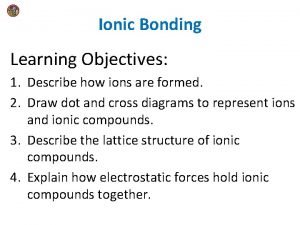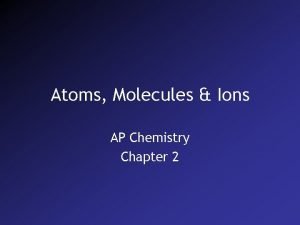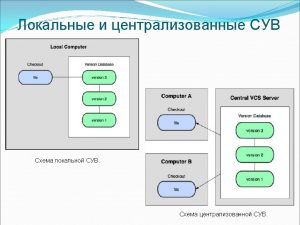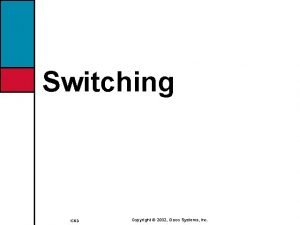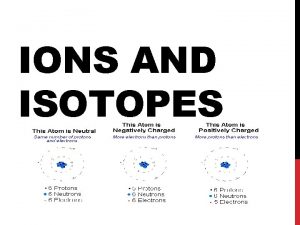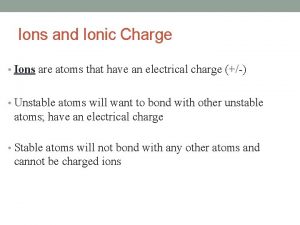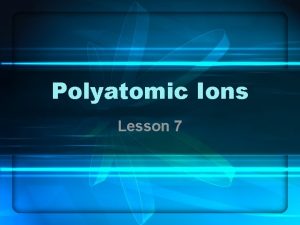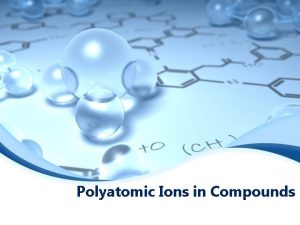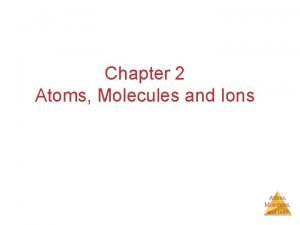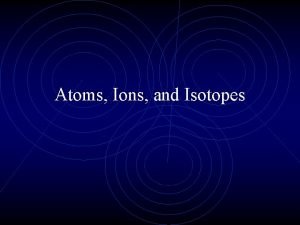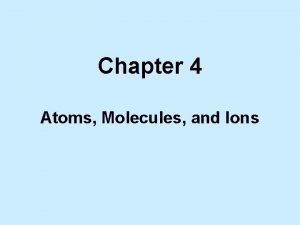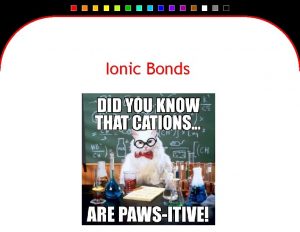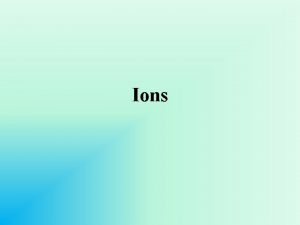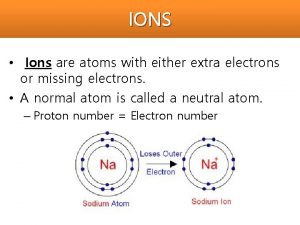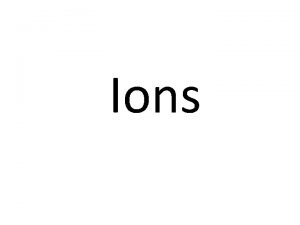IONS and E config u Ions are atoms























- Slides: 23

IONS and E config u Ions are atoms that have lost or gained electrons. u Remember that the number of protons cannot change for an element. u When an atom gains more electrons than the number of protons it has it will have a negative charge.

u When an element loses more electrons than the number of protons it has, it will have a positive charge. u What drives atoms to give away electrons or take on more?

Driving Force u Full Energy Levels are very low energy u Noble Gases have full orbitals u Atoms behave in ways to achieve noble gas configuration

Ionic Size u Cations are positive ions u Cations form by losing electrons u Cations are smaller than the atom they come from u Metals form cations u Cations of representative elements have noble gas configuration.

Ionic size u Anions are negative ions u Anions form by gaining electrons u Anions are bigger than the atom they come from u Nonmetals form anions u Anions of representative elements have noble gas configuration.

Configuration of Ions u. Ions of representative elements have noble gas configuration is 1 s 22 p 63 s 1 u Forms a 1+ ion - 1 s 22 p 6 u Same configuration as neon u Metals form ions with the configuration of the noble gas before them - they lose electrons u Na

Configuration of Ions u Non-metals form ions by gaining electrons to achieve noble gas configuration. u They end up with the configuration of the noble gas after them.

Group trends u Adding energy level u Ions get bigger as you go down H 1+ Li 1+ Na 1+ K 1+ Rb 1+ Cs 1+

Periodic Trends u Across the period nuclear charge increases so they get smaller. u Energy level changes between anions and cations Li 1+ B 3+ Be 2+ C 4+ N 3 - O 2 - F 1 -

Keeping Track of Electrons u The electrons responsible for the chemical properties of atoms are those in the outer energy level. u Valence electrons - The s and p electrons in the outer energy level. u Core electrons -those in the energy levels below. u Basis for shorthand

Keeping Track of Electrons u Atoms in the same column u Have the same properties because u Have the same outer electron configuration. u Have the same valence electrons. u Found by looking up the group number on the periodic table. u Group 2 A - Be, Mg, Ca, etc. u 2 valence electrons

Lewis Dot diagrams help us determine the charge

Electron Dot diagrams u. A way of keeping track of valence electrons. u How to write them u Write the symbol. u Put one dot for each valence electron u Don’t pair up until they have to X

The Electron Dot diagram for Nitrogen § Nitrogen has 5 valence electrons. § First we write the symbol. §Then add 1 electron at a time to each side. §Until they are forced to pair up. N

Write the electron dot diagram for Na F Mg Ne C He O

Electron Configurations for Cations u Metals lose electrons to attain noble gas configuration. u They make positive ions. u Na 1 s 22 p 63 s 1 - 1 valence electron u Na+ 1 s 22 p 6 -noble gas configuration

Electron Dots For Cations u Metals will have few valence electrons Ca

Electron Dots For Cations u Metals will have few valence electrons u These will come off Ca

Electron Dots For Cations u Metals will have few valence electrons u These will come off u Forming positive ions 2+ Ca

Electron Configurations for Anions u Nonmetals gain electrons to attain noble gas configuration. u They make negative ions. u S 1 s 22 p 63 s 23 p 4 - 6 valence electrons u S 2 - 1 s 22 p 63 s 23 p 6 -noble gas configuration.

Electron Dots For Anions u Nonmetals will have many valence . electrons. u They will gain electrons to fill outer shell. P 3 P

Practice u Use electron dot diagrams to show the following form ions u Al u Cl u. C

Stable Electron Configurations u All atoms react to achieve noble gas configuration. u Noble gases have 2 s and 6 p electrons. u 8 valence electrons. u Also called the octet rule. Ar
 Insidan region jh
Insidan region jh Ion chapter 11
Ion chapter 11 Atoms molecules and ions
Atoms molecules and ions Atoms molecules and ions
Atoms molecules and ions Atoms molecules and ions
Atoms molecules and ions Atoms ions and molecules
Atoms ions and molecules Atoms ions and molecules
Atoms ions and molecules States that atoms ions and molecules must collide to react
States that atoms ions and molecules must collide to react Chapter 2 atoms molecules and ions
Chapter 2 atoms molecules and ions Regents periodic table
Regents periodic table What do the roman numerals in a cation's name indicate
What do the roman numerals in a cation's name indicate Positive ions are atoms that have
Positive ions are atoms that have Atoms or ions are considered isoelectronic if
Atoms or ions are considered isoelectronic if Git config global user
Git config global user Wlcca
Wlcca Kernel config
Kernel config Slidetodoc
Slidetodoc Franzj config
Franzj config Xen hvm config
Xen hvm config Config t
Config t Spring cloud config alternatives
Spring cloud config alternatives Cisco tftp default disable
Cisco tftp default disable Samba web administration tool
Samba web administration tool Cisco network configuration manager
Cisco network configuration manager











